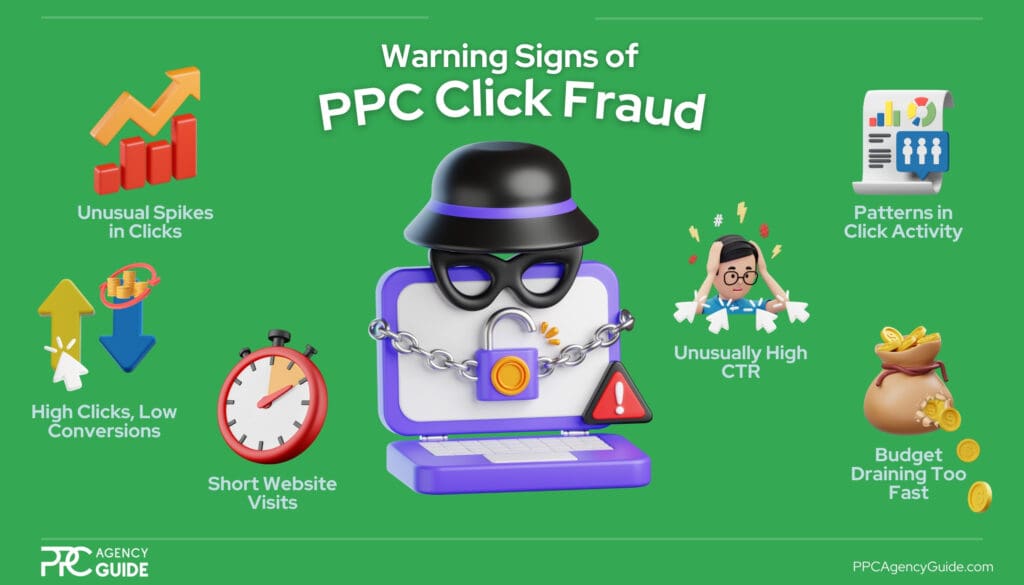
Your ad budget is disappearing, but where are the conversions? If you’ve ever felt like your PPC dollars are vanishing into thin air, click fraud might be to blame. Click fraud is a hidden threat that can eat away at your pay-per-click (PPC) campaigns without you even realizing it. From bots to competitors, fraudulent clicks not only drain your budget but also distort your data, making it harder to optimize your ads and reach real customers. But there is good news. Once you know how to spot the signs and take preventative action, you can regain control over your campaigns. In this guide, we’ll walk you through how to detect click fraud, protect your ads, and recover from its effects so you can focus on what really matters: growing your business.
Pay-Per-Click Click Fraud: The Basics
Before we get into how to address PPC click fraud, let’s go over the basics, like what it really is and how it impacts your advertising campaigns.
What is PPC Click Fraud?
PPC click fraud happens when someone, like a bot, a competitor, or even a random person, clicks on your ads without any real interest in what you’re offering. This artificially inflates your ad costs without giving you any genuine leads or sales.
Why Should You Care About Click Fraud?
Click fraud impacts your business in major ways.
- Wasted Ad Spend: Every fraudulent click eats into your PPC budget. If your daily budget gets maxed out by fake clicks, your legitimate customers might never see your ads.
- Skewed Analytics: Click fraud distorts the data you rely on to make smart marketing decisions. You might see high click-through rates (CTR) but wonder why conversions are so low. This can lead you to make misguided optimizations or even pause a campaign that actually has potential.
The Impact of Click Fraud
Businesses lose nearly $6 billion annually due to digital advertising fraud, Dark Reading reports. While that number includes various types of digital ad fraud, PPC is a significant portion. In competitive industries like legal services, insurance, and e-commerce, ten to 20 percent of a business’s PPC budget can be wasted on fraudulent clicks.
Small businesses aren’t immune. Even if you’re running a small or mid-sized campaign, click fraud can drain your budget quickly. Whether you’re in a competitive niche or just running local ads, you could see your performance drop and your costs skyrocket if you’re not actively monitoring for fraud.
Signs of PPC Click Fraud
Click fraud can be subtle, but there are a few key signs to watch out for if you want to catch it early before it drains your budget.

Unusual Spikes in Clicks
One of the first things you might notice is a sudden, unexplained spike in the number of clicks on your ads. If your campaign has been cruising along with a consistent 20 clicks a day and then suddenly shoots up to 100 overnight without a similar jump in conversions, something’s fishy. This kind of surge, especially when it doesn’t translate into sales or leads, could mean that bots or competitors are clicking your ads to drive up your costs.
High Clicks, Low Conversions
If you’re getting a lot of clicks, but those clicks aren’t turning into meaningful actions like sign-ups, purchases, or other conversions, that’s a big red flag. Click fraud can inflate your click-through rate (CTR) while leaving your conversion rate flat or, worse, declining. Keep a close eye on the ratio between clicks and conversions. If your CTR is rising but conversions aren’t, it’s time to dig deeper.
Short Website Visits
Check your analytics to see how long people are sticking around on your site after clicking your ad. Click fraud often leads to very short visits, where users (or bots) bounce almost immediately. If your average session duration drops and visitors are barely spending time on your landing page, you might be dealing with fraudulent clicks.
Patterns in Click Activity
Sometimes, fraud isn’t random. It follows patterns instead. If you notice clicks coming from the same IP address or a small cluster of geographical areas that you’re not targeting, that’s another indicator of click fraud. Additionally, if your ads are being clicked at odd hours when you wouldn’t expect your target audience to be active, that’s something to investigate.
Unusually High CTR
Click-through rates can vary by industry, but if you notice your CTR is suddenly sky-high compared to your typical performance or industry benchmarks, there’s reason for concern. A three percent CTR might be great for some industries, but if you’re seeing ten percent with little to no conversions, you’ve likely got fraudulent clicks in the mix.
Your Budget is Draining Too Fast
Lastly, if you notice your daily ad budget is getting used up way faster than expected, but you’re not seeing the results you’d anticipate, fraud could be the cause. If your budget is disappearing before noon and the leads aren’t there, it’s time to look for some of these other warning signs.
How to Prevent PPC Click Fraud
Preventing click fraud isn’t a one-and-done kind of thing. It’s more about staying on top of your campaigns and using a mix of strategies to protect your ad budget.
Tighten Up Your IP Exclusions
If you start noticing suspicious activity from a certain IP address, like repeated clicks with no conversions, you can actually block that IP from seeing your ads. It’s a simple but effective way to cut off fraud at the source. Google Ads allows you to exclude specific IP addresses, which means if someone (or some bot) keeps hitting your ads, you can stop them from ever seeing it again.
Keep an eye on your reports and regularly add those problematic IPs to your exclusion list. It’s like locking the door after a break-in. You don’t want to give them a second shot.
Get Smart with Geographic Targeting
Sometimes, click fraud comes from places you’re not even targeting. If you’re a business that only operates in a specific region, such as Chicago, there’s no reason your ads should be getting clicked by someone in the UK. Narrow down your targeting to specific locations that are relevant to your business. This cuts off a lot of potential fraudulent clicks right from the start.
For instance, if you’re running ads for a local bakery, there’s no value in showing those ads outside your delivery area. By focusing your ads geographically, you’ll reduce fraud and improve your chances of reaching actual customers.
Set Limits with Click Caps
Another way to prevent click fraud is to set up limits on how many times a person can click on your ad in a given period. Google Ads lets you set “click caps,” which can stop bots or overly aggressive competitors from repeatedly clicking on your ad to burn through your budget.
Imagine if someone clicks your ad five times within an hour. That’s suspicious, right? With click caps in place, after a few clicks, they won’t see your ad anymore, protecting your budget from abuse.
Use Click Fraud Protection Tools
There are entire platforms dedicated to spotting and stopping click fraud. Tools like ClickCease, Lunio, and Clixtell are designed to monitor your campaigns in real-time and catch suspicious activity before it eats up your ad spend. These tools can flag unusual click patterns, identify bots, and even block bad actors from seeing your ads again.
If you’re running a large PPC campaign, it’s worth investing in one of these tools. They’ll give you detailed reports on fraud activity and automatically take action to keep your campaigns clean. It’s like having an extra set of eyes on your ads 24/7.
Keep an Eye on Your Campaigns
It might sound obvious, but regular monitoring is key. If you’re only checking your campaigns every couple of weeks, fraudulent clicks could be going unnoticed for too long. Make it a habit to review your campaign metrics regularly. Look for unusual spikes in clicks, drops in conversions, or strange traffic patterns.
Even better, set up automated reports in Google Ads so you can get daily or weekly updates on your campaign’s performance without having to dig in manually.
Take Advantage of Google’s Built-In Protections
Google Ads actually has its own click fraud protections in place. They automatically filter out invalid clicks, like those from bots or accidental double clicks, so you don’t get charged for them. But you can go further by enabling extra features, like IP exclusions and ad scheduling, to control when and where your ads appear.
For example, if you notice fraud happens more at night, you can use ad scheduling to stop your ads from showing during those hours. It’s all about using the tools at your disposal to keep the fraudsters at bay.
What to Do if You Suspect Click Fraud is Occurring
So, you’ve noticed something off—maybe your budget is draining too quickly, or you’re seeing a ton of clicks without any conversions. Here’s a step-by-step approach to tackling it head-on.
Investigate the Signs
First things first, double-check the signs to confirm your suspicions. Head over to your ad dashboard and dive into the data. Look for unusual patterns like:
- Sudden spikes in clicks without an increase in conversions
- Clicks coming from the same IP address or region that you’re not targeting
- Very short session durations on your website
- Clicks occurring during odd hours, like late at night
You can also use Google Analytics to see how long people are spending on your site after clicking the ad. If it’s just a couple of seconds, that’s a red flag.
Use Google Ads’ Invalid Click Report
Google actually has a built-in report for invalid clicks, which is super useful. In your Google Ads account, head to the “Campaigns” tab and look for the column that shows “Invalid Clicks.” This tells you how many suspicious clicks Google has already filtered out. If you’re seeing a lot of invalid clicks, Google is already catching some of the fraud, but it may not be catching everything.
Set Up IP Exclusions
If your investigation turns up specific IP addresses or regions that are the source of fraudulent clicks, block them. In Google Ads, you can manually exclude IP addresses. This will prevent your ads from being shown to those users again.
Let’s say most of the fraudulent activity is coming from one particular area or IP address. Excluding them could save you from hemorrhaging ad spend.
Adjust Your Targeting
Take a closer look at your location and audience targeting settings. If you’re running broad campaigns, fraud can sneak in more easily. Narrowing your audience by geography or demographics can help reduce bad clicks. For example, if you’re a local business, make sure your ads are only showing to people in your immediate area to reduce the chances of fraud from unrelated regions.
Use a Click Fraud Detection Tool
If click fraud is a persistent issue, it’s time to bring in some extra help. Use one of the tools we mentioned earlier or something similar to monitor and prevent fraudulent clicks.
Request a Refund from Your Advertising Platform
Yes, you can actually get your money back for fraudulent clicks! If you’ve gathered enough evidence like IP addresses, time logs, and analytics reports, you can submit a refund request to Google Ads and other platforms. They won’t refund every click, but if they agree that the clicks were invalid, you’ll get credited back for the fraudulent activity.
To request a refund from Google, go to the Google Ads support page and submit your case. Include all the evidence you’ve gathered to strengthen your claim.
Keep Monitoring
Even after you’ve taken action, don’t let your guard down. Click fraud isn’t always a one-time thing. It can be ongoing or pop up in waves. Make monitoring a regular part of your routine by setting up alerts or scheduling regular checks on your campaign metrics. Use tools like Google’s automated reporting to help spot suspicious activity early.
How to Optimize Campaigns Post-Click Fraud
After you’ve dealt with click fraud, the next step is optimizing your campaigns to get things back on track and ensure you’re getting the best possible return on your ad spend moving forward. Here are some specific steps you should take to optimize campaigns post-click fraud.

Review and Clean Up Your Data
The first step is to review your data from the period when the fraud occurred. Fraudulent clicks can mess with your metrics, so you need to filter out the bad data to see what’s really going on. If you noticed a spike in clicks without conversions over a specific timeframe, remove that data from your reports so it doesn’t distort your analysis moving forward. Think of this as clearing the clutter before making any major decisions.
Reassess Your Budget Allocation
After experiencing click fraud, it’s likely that some campaigns or ad groups were hit harder than others. Take this opportunity to reassess how you’re distributing your ad budget. You might find that certain keywords or ad groups were affected more, and reallocating funds to campaigns that are performing better could help you recover faster. If any areas were particularly vulnerable to fraud, it might be worth pulling back on those temporarily while you make adjustments.
Tighten Your Targeting
Broad targeting can expose you to fraud, so now’s the time to refine it. Go back to your audience and geographic settings. If your campaigns were targeting too wide an area, narrow it down to focus on locations where your actual customers are. For example, if you’re a local business, ensure your ads aren’t being shown in regions you don’t serve. If fraud comes from mobile devices, consider adjusting your campaign to focus more on desktop traffic for a while.
Adjust Your Bidding Strategy
Click fraud can throw off automated bidding strategies, especially if you’re using a method like “Maximize Clicks.” If fraudulent clicks have skewed your data, it’s a good idea to switch to manual bidding temporarily. This way, you’ll have more control over where your money is going. Once things have stabilized and you’ve cleaned up your data, you can start testing automated bidding strategies again, such as “Target CPA” or “Target ROAS,” which focus on conversions rather than just clicks.
Refresh Your Ad Creatives
If bots or malicious actors repeatedly target your ads, it might be time to give your creatives a refresh. The fraud could have diminished their impact on real users, so updating your headlines, images, and calls to action can help reignite your campaign’s performance. Consider running A/B tests to see which new variations resonate best with your audience. If your messaging is too broad, try making it more specific to attract only the users who are genuinely interested in your offering.
Review Keyword Performance
Click fraud can distort the performance of your keywords, so it’s important to analyze them carefully. If certain keywords attracted a lot of clicks but no conversions, consider pausing or removing them from your campaigns. Conversely, you can add negative keywords to block irrelevant searches and prevent future fraudulent clicks. This helps refine your targeting and ensures your ads are shown to the right audience.
Monitor for Recurrence
Even after optimizing your campaigns, you’ll want to keep a close eye on things to ensure click fraud doesn’t make a comeback. Set up alerts in Google Ads to notify you of unusual activity, like sudden spikes in clicks or rapid budget depletion. You should also regularly audit your targeting settings and IP exclusions to ensure everything stays clean and optimized.
Work with an Expert to Address Click Fraud Prevention
The effects of click fraud can be catastrophic. If you need help preventing PPC click fraud or optimizing your campaigns after an incident to boost recovery, it’s best to work with an expert. We can match you with an experienced PPC agency that understands what to look for and can put processes in place to ensure your ad budget goes to people likely to convert, not bots and fraudsters. To take the first step toward securing your campaigns against ad fraud, request a complimentary PPC consultation.
PPC Fraud FAQs
How can I clean up my data after experiencing PPC click fraud?
Identify the time frame when fraud took place, then filter or remove the affected data from your reports. This can involve excluding traffic from certain IPs, geographic areas, or even specific times. By isolating fraudulent activity, you'll prevent distorted metrics from affecting your optimization decisions.
How do I adjust my budget after click fraud affects my PPC campaigns?
Once you’ve identified the impact of click fraud, shift your budget away from affected keywords or ad groups. Reallocate funds to campaigns and keywords that show consistent, positive performance. It’s also a good idea to reduce budgets in regions or areas where fraud was most prominent and invest more in proven, trustworthy segments.
What targeting strategies help prevent future PPC click fraud?
Narrow your targeting to focus on locations, devices, and audience segments that align with your business goals. Exclude regions or devices that generated suspicious clicks. You can also set up IP exclusions for areas where fraudulent activity originated. Regularly review and refine your targeting settings to stay ahead of fraud attempts.
How can manual bidding improve campaign performance after click fraud?
Manual bidding gives you greater control over where your ad spend goes, allowing you to adjust bids for specific keywords and avoid overpaying for clicks. After click fraud distorts automated bidding, switching to manual bidding lets you prioritize high-quality traffic while avoiding the risk of inflated costs from fraudulent activity.
Should I change my ad creatives after click fraud occurs?
Yes, refreshing your ad creatives can help reset your campaign’s performance. Create new variations of your ads and A/B test different headlines, images, or CTAs. This will help you attract genuine users while moving past any stagnation caused by click fraud. Focus on messaging that directly appeals to your target audience.
What keywords should I focus on after click fraud distorts my PPC data?
Review your keyword performance reports and pause any keywords that attracted suspicious clicks or failed to convert. Focus on high-intent keywords that drive conversions, and consider adding negative keywords to prevent irrelevant searches. Prioritize keywords that consistently perform well and align with your business objectives.
How can I monitor my PPC campaigns to prevent recurring click fraud?
Set up custom alerts in Google Ads to notify you of sudden spikes in clicks or unusual budget consumption. Regularly review campaign reports, paying close attention to click-through rates, conversion rates, and user behavior on your site. Use tools like ClickCease or Lunio to detect suspicious activity in real-time.
What tools can I use to detect and prevent PPC click fraud?
Tools like ClickCease, Lunio, and Clixtell are designed specifically to detect and prevent click fraud. These tools monitor your campaigns in real time, identify fraudulent activity, and block malicious IP addresses from accessing your ads. They also provide detailed fraud reports that you can use to submit refund requests.
How long does it take to recover from PPC click fraud?
Recovery time varies depending on the severity of the fraud. In most cases, you can clean up data, adjust budgets, and optimize targeting within a few days. However, if the fraud heavily impacted your metrics or automated bidding strategies, it may take longer to regain momentum and stabilize campaign performance.
What are the best practices for protecting my PPC campaigns from ad frauds?
Use IP exclusions to block fraudulent addresses and tighten your location targeting to focus on relevant areas. Regularly monitor your campaigns, set up click caps, and use fraud detection tools like ClickCease. Google Ads’ built-in protections also filter out some ad frauds, but adding extra layers of security can reduce your risk further.
How does Google fraud prevention help reduce the risk of click fraud in PPC campaigns?
Google fraud prevention includes automatic detection and filtering of invalid clicks, such as bots or accidental double clicks. Google Ads also offers IP exclusion and ad scheduling features that help you block suspicious activity and control when and where your ads appear. These tools help reduce the financial impact of fraudulent clicks on your campaigns.


















